African Cats
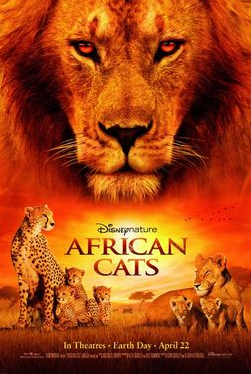
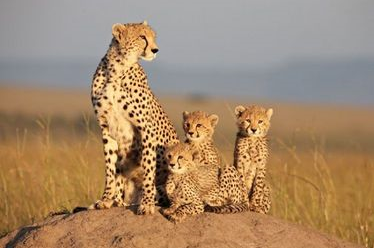 The film has been edited in such a way so that it tells a simple narrative story, with the voice of Samuel L. Jackson guiding us through it. Some have criticized the film for the fact that it gives the individual animals names, accusing the film of anthropomorphizing its subjects. But, it's a common practice for nature researchers to give names to their subjects while they're observing them, and it never feels like the film is trying to give human-like qualities to the animals, although Jackson's narration does attempt to know what the creatures are thinking from time to time. On Kenya's Masai Mara Natural Reserve, we meet two different families of African cats who live on different sides of the Reserve, divided by a crocodile-infested river. On the North side of the river, we meet "Sita", a cheetah who is trying to raise her five young cubs, with the constant threat of attacks by hyenas and rival cheetahs always just around the bend. On the South, an aging lioness named "Layla" tries to hold her own amongst her pride, despite her increasing injuries from unsuccessful hunts, and also protect her young cub, "Mara".
The film has been edited in such a way so that it tells a simple narrative story, with the voice of Samuel L. Jackson guiding us through it. Some have criticized the film for the fact that it gives the individual animals names, accusing the film of anthropomorphizing its subjects. But, it's a common practice for nature researchers to give names to their subjects while they're observing them, and it never feels like the film is trying to give human-like qualities to the animals, although Jackson's narration does attempt to know what the creatures are thinking from time to time. On Kenya's Masai Mara Natural Reserve, we meet two different families of African cats who live on different sides of the Reserve, divided by a crocodile-infested river. On the North side of the river, we meet "Sita", a cheetah who is trying to raise her five young cubs, with the constant threat of attacks by hyenas and rival cheetahs always just around the bend. On the South, an aging lioness named "Layla" tries to hold her own amongst her pride, despite her increasing injuries from unsuccessful hunts, and also protect her young cub, "Mara".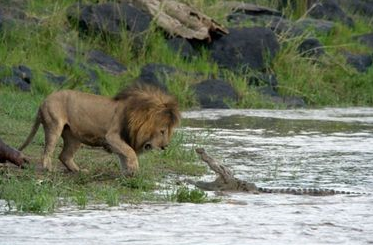 With the film's strong emphasis on the relationship between a mother and its children, it's perhaps appropriate that I happened to see this movie over Mother's Day weekend, instead of on its original Earth Day release date. The film does not shy away, however, from the many dangers these mothers face. The biggest threat in the film comes from "Kali" and his four sons, a lion who wants to dethrone the current ruler of Layla's pride, "Fang", and increase his rule over the land. Despite the film's G-rating, parents should be advised that the film contains not only some brutal attacks (which are kept mostly off camera, but show just enough that might scare some small kids), but also some moments of quiet despair. Such moments include Sita being separated from her cubs after an attack, and facing the possibility that they may have been killed by prowling hyenas, and a particularly heartbreaking sequence where Layla has suffered too many injuries, and can no longer go on with her pride, her cub Mara leaving her behind.
With the film's strong emphasis on the relationship between a mother and its children, it's perhaps appropriate that I happened to see this movie over Mother's Day weekend, instead of on its original Earth Day release date. The film does not shy away, however, from the many dangers these mothers face. The biggest threat in the film comes from "Kali" and his four sons, a lion who wants to dethrone the current ruler of Layla's pride, "Fang", and increase his rule over the land. Despite the film's G-rating, parents should be advised that the film contains not only some brutal attacks (which are kept mostly off camera, but show just enough that might scare some small kids), but also some moments of quiet despair. Such moments include Sita being separated from her cubs after an attack, and facing the possibility that they may have been killed by prowling hyenas, and a particularly heartbreaking sequence where Layla has suffered too many injuries, and can no longer go on with her pride, her cub Mara leaving her behind.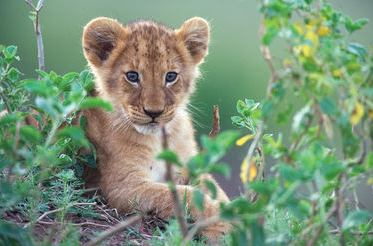 With its simple and almost human narrative, African Cats may not be as educational as it could have been. (For that, look to National Geographic's recent documentary, The Last Lions.) Instead, filmmakers Alastair Fothergill and Keith Scholey should be applauded for their stunning footage. Assembling their film out of two years of following these animals, there are some breathtaking moments, especially during the hunting scenes, or the quiet moments of the young cubs at play or making new discoveries. The movie works entirely on an emotional level. It's nearly impossible not to have your heartstrings pulled at least once while watching the film. I can see how those who are looking for an informative film about the nature of lions could be somewhat disappointed by the film's simplistic approach. But those who just want to get close to these creatures and share an emotional journey will not be disappointed.
With its simple and almost human narrative, African Cats may not be as educational as it could have been. (For that, look to National Geographic's recent documentary, The Last Lions.) Instead, filmmakers Alastair Fothergill and Keith Scholey should be applauded for their stunning footage. Assembling their film out of two years of following these animals, there are some breathtaking moments, especially during the hunting scenes, or the quiet moments of the young cubs at play or making new discoveries. The movie works entirely on an emotional level. It's nearly impossible not to have your heartstrings pulled at least once while watching the film. I can see how those who are looking for an informative film about the nature of lions could be somewhat disappointed by the film's simplistic approach. But those who just want to get close to these creatures and share an emotional journey will not be disappointed.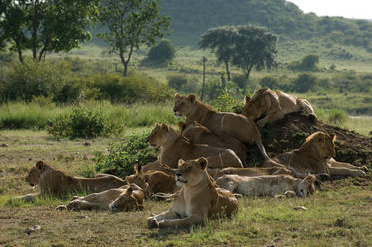
See the movie times in your area or buy the DVD at Amazon.com!






0 Comments:
Post a Comment
<< Home